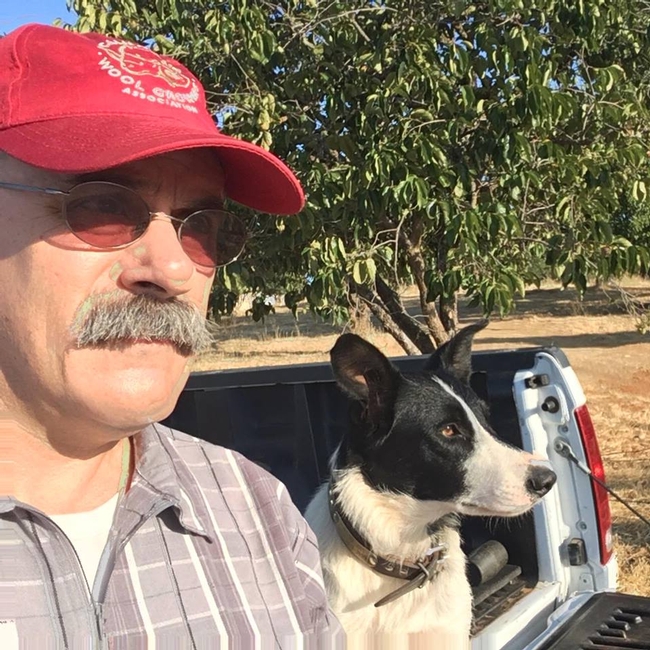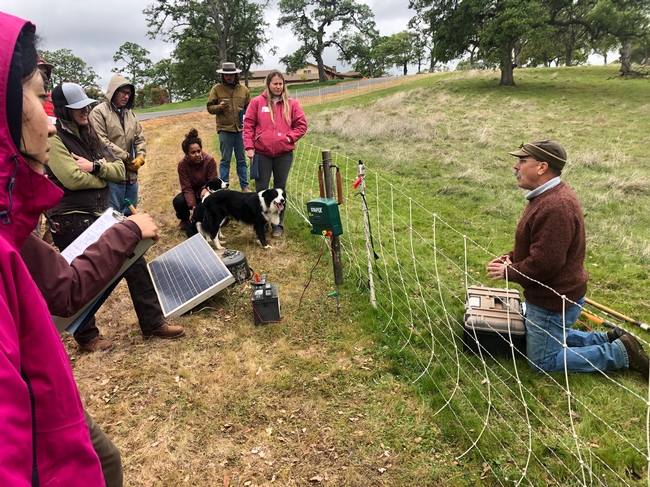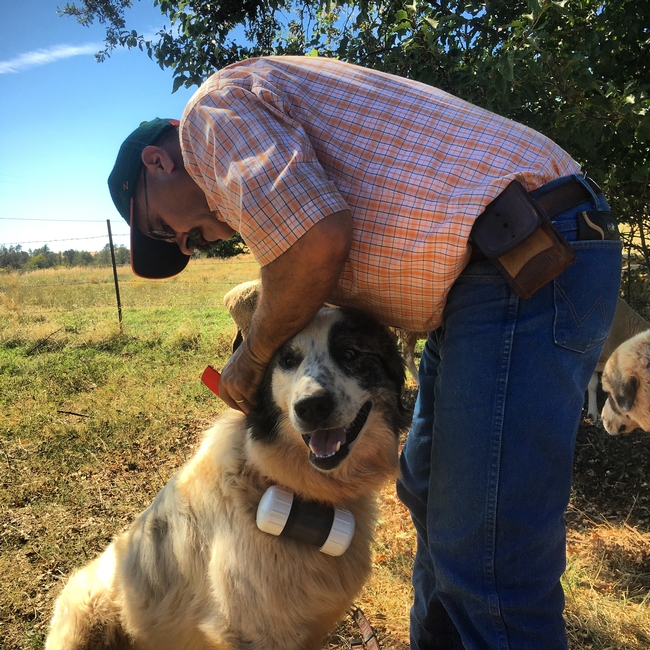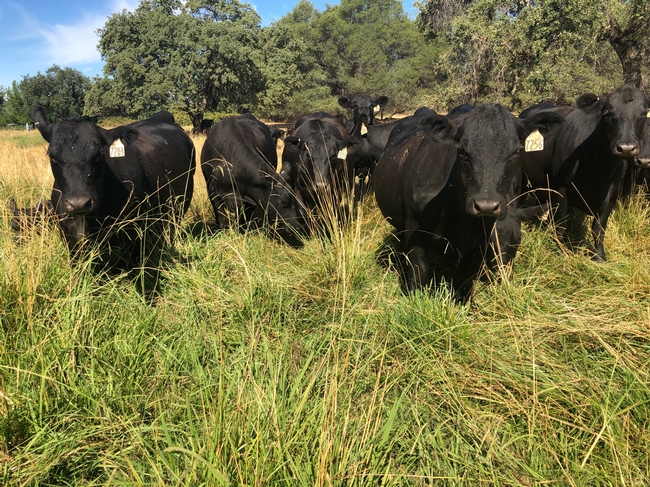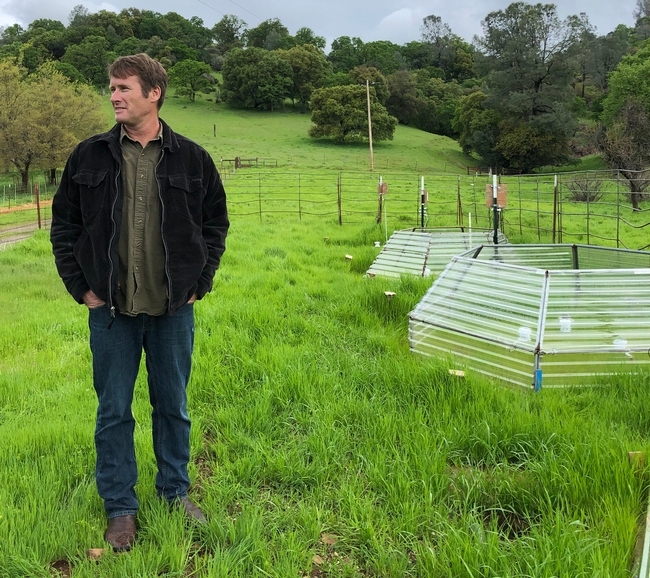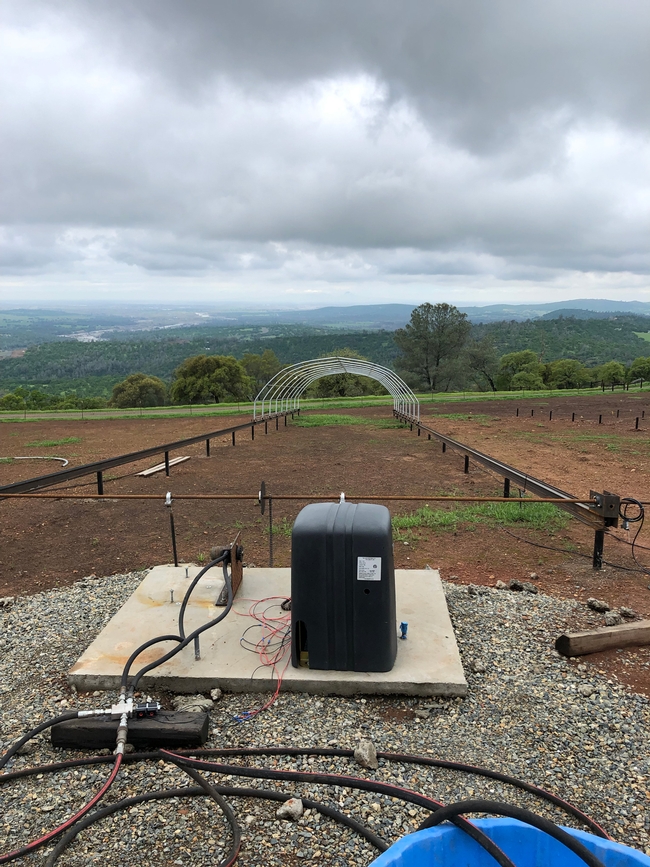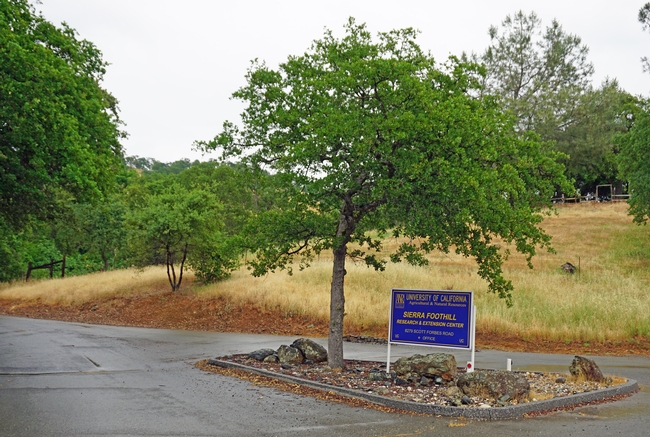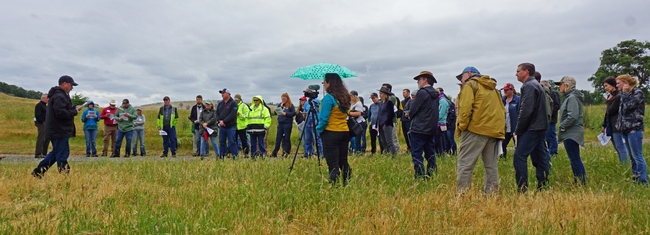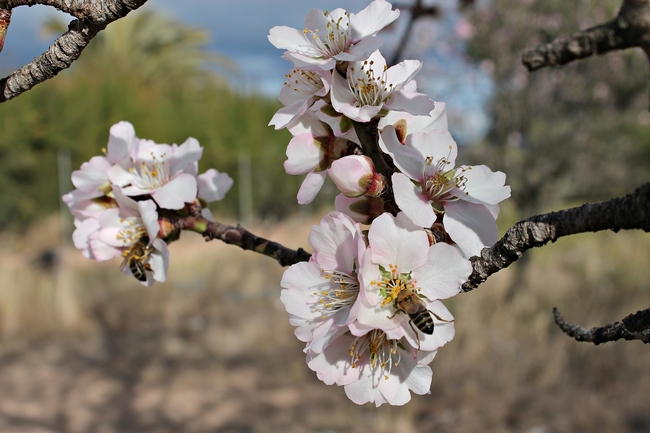Posts Tagged: Dan Macon
UCCE advisor’s breadth of experience and education support ranchers’ economic viability
This is one of a series of stories featuring a sampling of UC ANR academics whose work exemplifies the public value UC ANR brings to California.
Livestock and natural resources advisor Dan Macon came to UC Cooperative Extension three years ago with much more than a formal education in integrated resource management and agricultural and managerial economics.
He had years of hands-on experience running a successful foothill sheep operation, toiling long days and often into the night tending animals, irrigating pastures, training livestock guardian dogs and managing forage.
“I came to this position mid-career,” said Macon, who also accumulated skills working for a family auction company and in various capacities for the California Cattlemen's Association, the California Rangeland Trust and USDA's Natural Resources Conservation Service.
The love of a rural lifestyle prompted his family to purchase a small ranch in Auburn to raise sheep 15 years ago. Natural communication skills led Macon to become respected local blogger at Foothill Agrarian and, eventually, a social media influencer with nearly 2,000 followers on Instagram @flyingmule.
When Macon bought his ranch, he needed help dealing with invasive Himalayan blackberries. He called Roger Ingram, the UCCE livestock and natural resources advisor in Placer and Nevada counties from 1997 to 2017.
“Roger helped me take care of the problem,” Macon said. “Following his recommendation, I bought goats and they grazed the blackberries into submission. Now the grass can out-compete the invasive plants. We've turned the area into grassland.”
Macon began volunteering for UC Cooperative Extension by teaching fellow ranchers about his experiences raising sheep, managing rangeland and raising and training livestock guardian dogs. Macon was a presenter at Ingram's annual California Multi-Species Browsing Academy.
“I finally recognized that the parts of my earlier jobs that I most enjoyed involved things I'd be doing on a daily basis as a farm advisor – teaching and research,” Macon said. He earned a master's degree from Colorado State University and applied to succeed Ingram after his retirement. Macon also took on the role in Sutter and Yuba counties, succeeding Glenn Nader.
Livestock production in the Sierra Nevada foothills ranks among the top five agricultural commodities. Economic viability is a major issue. Macon's research and extension program is focused on ranch economics and business management, drought resilience, predator-livestock coexistence and irrigated pasture management.
At the UC Sierra Foothill Research and Extension Center in Browns Valley, Macon is conducting research that will help ranchers make decisions about maintaining a cattle herd when faced with impending drought. Even when the weather forecast is dry and forage isn't growing at a sufficient pace, ranchers can be reluctant to sell off their cattle.
“Science tells us you shouldn't try to feed your way out of a drought,” Macon said. “Ranchers want everything to stay the same. They want to maintain their genetic potential and keep cows that are familiar with the area.”
The research will compare cows weaned on a traditional weaning schedule with others that are weaned early.
“The cattle will be out on the range from March to early September under different parameters,” Macon said. “We're also tying in economics, the value of genetic potential and the value of having cows who know the landscape.”
Macon is securing funding to conduct research on livestock guardian dogs in different production settings. Using low-cost GPS technology developed at New Mexico State University, Macon plans to study the relationship between dogs, predators and livestock in terms of space and time.
“One unknown is whether they displace predators or disrupt predatory behavior,” Macon said.
Macon uses livestock guardian dogs on his ranch and will be able to draw on his own experiences in designing the study. He recently wrote a fact sheet on guardian dog selection with UCCE human-wildlife interaction advisor Carolyn Whitesell.
“We've had great success with our guardian dogs,” he said. “But not everyone has that level of success. Using scientific tools like remote sensing and GPS technology will give us more details about wildlife-guardian dog-livestock interactions.”
During this year's shelter-in-place, Macon has become more creative in reaching out with scientific ranching information. He and large-scale sheep producer Ryan Mahoney of Rio Vista created a weekly podcast, “Sheep Stuff Ewe Should Know.” Early episodes cover such topics as risk management, the effects of COVID-19 on the sheep industry and livestock guardian dogs. The podcast is available on Spotify and other mobile podcast apps.
Macon developed a new bi-weekly webinar series, “Working Rangeland Wednesday,” with UCCE specialist Leslie Roche and UC Davis graduate student Grace Woodmansee. Recordings are posted on YouTube.
Traditional, one-on-one farm calls are also a part of Macon's extension program. He conducts five or six a month. Even so, the COVID-19 pandemic prompted Macon to begin remote advising. Soon after Gov. Newsom's shelter-in-place order was issued, Macon got a call from a woman whose ewes had recently given birth.
“She thought the lambs weren't doing well and wondered what she could do,” Macon said. “We both had Facetime, so I asked her to show me what the sheep looked like. I was able to assure her that things were normal and suggested bottle feeding. I talked to her several times over the next couple of days, and she was able to save the lambs.”
Most queries from local ranchers center on pasture or grass management, species composition, fencing, paddock design and animal husbandry. Last year, ranchers called with blue oaks suddenly and inexplicably dying on their land.
“The trees had no visible injuries. Ranchers were wondering if it was a lingering effect of drought or due to habitat fragmentation,” Macon said.
Macon contacted UC Cooperative Extension plant pathology specialist Matteo Garbelotto, a UC Berkeley-based tree disease expert. The scientists collected scorched leaves, wood samples and soil near the trunks of the dead or dying trees. They found evidence of fungi Botryosphaeria corticola and B. dothidea in wood chips collected at breast height. However, blue oak is not an official host for the two pathogens in the USDA fungus-host database.
The researchers believe that recent droughts and climate change may be causing an increased and widespread susceptibility of blue oaks or that an unknown pathogen may be increasing the susceptibility of blue oak to the canker disease. The progress made in solving these mysterious blue oak deaths was published in the most recent California Agriculture journal and will be the subject of continuing investigations in the future by Macon and his colleagues.
New UC studies outline costs of producing irrigated pasture in the Sierra Nevada foothills
Two new studies on the costs and returns of establishing and producing irrigated pasture in the Sierra Nevada Foothills have been released by UC Agriculture and Natural Resources' Agricultural Issues Center. Ranchers in Nevada, Placer and surrounding counties may find the cost estimates useful for planning.
Based on 40 acres of leased ground, the studies focus on establishment by tilling the soil, using conventional cultural practices and re-establishment of pasture using no-till cultural practices. The two separate studies, by Dan Macon, UCCE livestock and natural resources advisor, and Donald Stewart of the Agricultural Issues Center, estimate the cost of establishing or re-establishing a pasture and producing pasture over its 30-year life span.
There are two methods of establishing a pasture. One method uses conventional cultural practices, destroying the existing pasture and preparing the soil, or seed-bed, using conventional tillage practices.
The other no-till method of re-establishing the pasture uses high-intensity grazing and herbicides to destroy the existing pasture and plant new pasture using a no-till seed drill.
Their analysis reports the differences of machinery costs and methods. The reported prices for materials, equipment and custom services are based on January 2020 figures.
UC Cooperative Extension farm advisors, specialists, grower cooperators and other agricultural associates provided input and reviews. The authors describe the assumptions used to identify current costs for pasture establishment and production, material inputs, cash and non-cash overhead. A ranging analysis table shows profits over a range of prices and hay yields.
The new studies are “2020 - Sample Costs to Establish or Reestablish and Produce Irrigated Pasture in the Sierra Nevada Foothills, Flood Irrigated” and “2020 - Sample Costs to Produce Irrigated Pasture in the Sierra Nevada Foothills, Flood Irrigated.”
Both studies can be downloaded from the UC Davis Department of Agricultural and Resource Economics website at http://coststudies.ucdavis.edu. Sample cost-of-production studies for many other commodities are also available on the website.
For additional information or an explanation of the calculations used in the studies, contact Donald Stewart at the Agricultural Issues Center at (530) 752-4651 or destewart@ucdavis.edu.
For information about irrigated pasture establishment and production in Placer, Nevada, Sutter and Yuba counties, contact UCCE livestock and natural resources advisor Dan Macon at dmacon@ucanr.edu.
UC ANR research to determine future climate change impacts today
Scientific evidence of a warming climate in California and across the globe is clear, but the impacts on ecosystems and agriculture are still difficult to predict.
Sophisticated computer models are used to forecast future climate. Understanding that temperature and precipitation levels will change in the future does not tell the full story: UC Agriculture and Natural Resources researchers also want real-world experience under those future conditions.
Moreover, some agricultural operations have higher sensitivity to the changes than others. Rangeland forage is particularly sensitive to climate changes since, unlike irrigated agriculture, ranchers rely solely on precipitation. They have no control over how much and when it rains.
“It's tricky business,” said rangeland expert Jeremy James, the director of the UC Sierra Foothill Research and Extension Center in Browns Valley. “It's not easy to forecast. We have to address the uncertainty in a realistic manner.”
Discovering climate change impact on rangeland
In order to study different climate projections on rangeland, James and Maggi Kelly, director of the UC ANR Informatics and Global Information Systems special program, have begun development of a research site that will allow scientists to manipulate the temperature and rainfall on sections of rangeland to understand what would happen under predicted weather scenarios.
With a $220,000 National Science Foundation grant, construction is now underway on a four-acre site at the research center that will help scientists learn how temperature and precipitation will impact growth and diversity of forage that ranchers use to raise their livestock.
“We need to know how rangelands will respond when conditions change,” James said. “Will we grow more, but dry out earlier? Will we have more medusahead (an undesirable rangeland weed) or more soft chess (a high quality forage)?”
When complete, 16 shelters on steel tracks will be connected to computer systems and hydraulic motors to move them up or down a research plot. The shelters and other equipment will allow scientists to precisely control the amount of precipitation (or irrigation water) that rains onto the plot. Other systems will give researchers control of air temperature.
“This facility isn't designed for one type of research,” James said. “It is designed to conduct a wide variety of research by scientists over the next several decades. With this setup, we can look at the effect of climate change on soil biological communities, soil carbon, insect communities, plant-insect interactions and oak seedling recruitment.”
The research results from the project should provide ranchers and land managers a better understanding of how climate change may impact agriculture and ecosystem function on rangeland while also providing important information on how to minimize impacts of these changes.
Some aspects of the research facility's development are not covered with funding from the National Science Foundation. The scientists are looking for additional support to complete the project.
For more information, contact James at jjjames@ucanr.edu.
Current work underway at the Sierra Foothill Research and Extension Center
The Sierra Foothill REC, a 5,000-acre facility on the Yuba River, has supported research, education and outreach in the Sierra foothills since 1960. Multiple lines of research are being conducted at SFREC. During a recent workshop, scientists from UC Davis, UC Berkeley and UC Cooperative Extension shared a sampling of their work at SFREC.
UCCE livestock and natural resources advisor Dan Macon described a project aimed at helping ranchers make decisions about maintaining a cattle herd when faced with impending drought. Ranchers are reluctant to sell off their cattle even when the near future weather forecast is dire.
“Science tells us you shouldn't feed your way out of a drought,” Macon said. “But you want everything to stay the same. You want to maintain your genetic potential and keep cows that are familiar with the area.”
Working with ranchers, the research project will compare management practices to determine the best way forward when the future looks meteorologically bleak.
“We're assigning cows to a traditional weaning and early weaning groups,” Macon said. “They'll be out on the range from March to early September under different parameters. We're also tying in economics, the value of genetic potential and the value of having cows who know the landscape.”
Research by University of Oregon post doctorate researcher Ashley Shaw is looking into whether compost applied to rangeland will help mitigate climate change by sequestering more carbon, and also benefit forage under drought by increasing the soil's water-holding capacity and improving nutrient delivery.
Preliminary results are promising. A single application of 1/4-inch of compost resulted in forage production that was higher than areas where no amendment was applied and areas that were treated with a chemical fertilizer.
“The biggest impact was under drought shelters,” said Shaw, referring to PVC frames that were covered with plastic during rain events to understand the impact of the treatment under dry conditions. “In the drought plots, the areas where compost was applied are staying green longer.”
A defining research tool at SFREC is a dataset that includes information on monthly rainfall and forage production going back 40 years.
A review of the data shows surprising variations and correlations at the center, where forage production averages 3,000 pounds per acre, but ranges from about 1,000 pounds per acre in 1987, to over 5,000 pounds per acre in 2018, when there was so much growth, “we didn't have enough animals to graze,” James said.
The dataset paints a spectrum of the variation that ranchers across the state must navigate to manage their livestock and rangeland in a way that is profitable and ecologically sound. Research at the Sierra Foothill REC offers invaluable information to help them better understand the ecosystem and make informed decisions.
May 2018 News Clips
Mien farmers get advice for growing strawberries in Yolo County
(Woodland Daily Democrat) ANR news release, May 31
Abnormal Weather Takes a Toll on California Olive Crop
(Ag Net West) Brian German, May 30
The late winter freeze caused significant issues for several different commodities throughout the state and has been especially problematic for the California olive crop. The fluctuating temperatures have created substantial concern among the industry as bloom looks to be far below normal levels.
“Overall we're a little on the pessimistic side. The bloom, on the whole, has been pretty poor, many orchards actually have a very light, to next to no bloom at all,” said Dani Lightle, Cooperative Extension Orchard Systems Advisor for Glenn County. “There's an orchard here or there that looks pretty good, but on the whole, it is a little bit dismal.”
http://agnetwest.com/weather-takes-toll-california-olive-crop/
How Avocados Define LA and the Secret to Making the Best Damn Avocado Toast
(LA Taco) Gab Chabran, May 29
…Eric Focht who is a staff research associate in the lab of Mary Lu Arpaia at UC Riverside through UC Agriculture and Natural Resources and the Department of Botany and Plant Sciences tells L.A. Taco that the recent avocado economy boom is “similar to what we see today with something like bitcoin.” He helps run a breeding program at UCR studying different avocados varieties, focusing mostly on Hass avocados but also looking at other less known versions of the popular fruit.
In short, he is working on breeding the perfect avocado that tastes great and is easier, faster, and less water-dependent to grow. This year is shaping out to be a good one for avocados, but this issue is always one to keep in mind.
Focht states that in the future, there will likely be more variety available in the mainstream marketplace. One varietal that Focht gets excited about is the Reed avocado which has now been popping up in places such as Whole Foods. It's known for its round, dinosaur egg shape and is about the size of a softball. It has a relatively large seed but the edible flesh is sometimes double or even triple that of a Haas that can make a lot more people happier per individual fruit.
http://www.lataco.com/how-avocados-define-l-a-and-the-secret-to-making-the-best-damn-avocado-toast/
Amazing graze
(Chico News & Review) Ashiah Scharaga, May 24
When drifting clouds dapple the sky and vibrant wildflowers—tickled pink buds, honey-hued petals and virent stems—awaken in the verdant fields of Table Mountain, explorers quicken their pace. They spot trickling streams and grazing cattle. Occasionally, they look straight down, turning anxious eyes to their mud-slicked heels—did they step in one of the fertile cow-pie mines littered across the landscape?
That may seem a nuisance, but it's a necessity. Tracy Schohr, a livestock and natural resources adviser for University of California Cooperative Extension, said the natural magic of the popular Butte County recreational spot is made possible because of a long-standing grazing program. “If cattle were not actually on Table Mountain Ecological Reserve,” she said, “essentially those invasive species would choke out those native plants, and they wouldn't be there.”
… In the past, grazing was misunderstood and primarily viewed as destructive, said Dave Daley, a fifth-generation Butte County cattleman and associate dean of Chico State's College of Agriculture. He credits changing perspectives to the development of grazing science, fueled by people such as Schohr and Kate Wilkin, a UC Cooperative Extension forestry, fire science and natural resource adviser for Butte, Yuba, Sutter and Nevada counties. (Schohr covers Butte, Plumas and Sierra counties.)
https://www.newsreview.com/chico/amazing-graze/content?oid=26315855
Sheep Shearing 101: Why Aspiring Shavers Flock to This California School
(KQED) Tiffany Camhi, May 23
…“We try to get the students shearing the first day because they make a lot of mistakes,” says John Harper, head of the UC Cooperative Extension Sheep Shearing School in Hopland.
Harper says if you can make the right moves with your feet, everything else falls into place.
“We're dancing instructors,” says Harper. “It's like 'Dancing With The Stars' on steroids, but with sheep.”
Around this time of year, hundreds of thousands of sheep in California need to have their wool shaved off. But Harper says there's a shortage of sheep shearers worldwide.
That's why he started the school in Hopland about 25 years ago.
Dan Macon of the California Wool Growers Association says the growing popularity of backyard flocks in California (usually just a handful of sheep) is adding to the demand for shearers, too.
“Infrastructure of the sheep industry is a key component,” says Macon. “Having people with that kind of skill and willingness to work hard is desperately needed.”
AUDIO: Hey, Salad Lovers: It's OK To Eat Romaine Lettuce Again
(NPR Morning Edition) Allison Aubrey, May 23
…After a big foodborne illness outbreak linked to baby spinach back in 2006, the leafy greens industry put in place a number of procedures to prevent contamination. "Prevention became the major focus after that outbreak," says Michele Jay-Russell, a food safety researcher at the University of California, Davis.
"They set up intensive testing protocols to monitor water quality," Jay-Russell says. The industry also agreed on standardized setbacks — or buffers — to separate growing fields from livestock operations, which can be a source of E.coli contamination. "You want a safe distance from where you're growing fresh produce and where you have concentrations of animals, like on a feedlot or dairy," she says.
Are avocados toast?
(Grist) Nathanael Johnson, May 22
…When Katherine Jarvis-Shean was a doctoral candidate researching the decline of cold winters a few years back, she thought more farmers should be freaking out. “I used to think, ‘Why aren't you guys more worried about this? It's going to be the end of the world.'”
After all, many fruit and nut trees require a good winter chill to bear fruit. But after spending a few years as an extension agent for the University of California — working directly with farmers and translating science into techniques they can apply on the land — she understands better. It comes down to this: Farmers have a ton of concerns, and the climate is just one of them.
“If you decide what to plant based on climate, but then can't make the lease payment, that's not sustainable,” Jarvis-Shean said.
https://grist.org/article/whatll-we-eat-in-2050-california-farmers-are-placing-bets/ https://www.wired.com/story/are-avocados-toast/
Lanternflies Eat Everything in Sight. The U.S. Is Looking Delicious.
(New York Times) Zach Montague, May 21
…Native to Asia, lanternflies first appeared in Pennsylvania in 2014. Despite a quarantine effort, they have also been discovered in small numbers in New York, Delaware and Virginia.
… “Most pests deposit their eggs on their host plant, or very close, so they already have food available,” said Surendra Dara, an adviser at the University of California Cooperative Extension.
“Those that have the advantage of being able to lay eggs on non-plant material obviously have a better chance of surviving and spreading,” he added.
https://www.nytimes.com/2018/05/21/science/lanternflies-pennsylvania-crops.html
Garbanzos are catching on in Yolo County
(Woodland Daily Democrat, Ag Alert) Bob Johnson, May 19
…“The largest part of our crop goes to canning, maybe 90 percent,” said Paul Gepts, UC Davis plant sciences professor and legume breeder. “California can only compete with high quality products. We have other varieties with higher yields, but the seeds are too small. The growers get a premium for larger, high quality seeds.”
Gepts developed the two newest UC garbanzo varieties, Vega and Pegasus. Both have large, attractive seeds well suited for the canning market, and both have resistance to Ascochyta blight, a fungal disease that can devastate the crop.
… “I think growers are more interested in garbanzos because it's a winter crop, and wheat prices are low,” said Rachael Long, UC Cooperative Extension farm adviser in Sacramento, Solano and Yolo counties. Long is finishing up UC's first Garbanzo Production Manual, which should be available before the end of the year.
http://www.dailydemocrat.com/article/NI/20180519/NEWS/180519787
A French Broom smack-down
(Napa Valley Register) Elaine de Man, May 18
…If we all pull together and pay attention, we can eradicate French broom and send it packing. But it's going to take many, many hands and a concerted effort. It's going to take a village.
1. U.C. Agriculture and Natural Resources, Statewide Integrated Pest Management Program, http://ipm.ucanr.edu/PMG/PESTNOTES/pn74147.html
Kale, Not Jail: Urban Farming Nonprofit Helps Ex-Cons Re-enter Society
(New York Times) Patricia Leigh Brown, May 17
Even by the standards of the Bay Area, where sourcing local, organic chicken feed is seen as something of a political act, the spectacle of 30,000 fruit and nut trees being tended by formerly incarcerated orchardists is novel.
…Jennifer Sowerwine, an urban agriculture specialist for the University of California Cooperative Extension at Berkeley, said that Ms. Haleh and Mr. Raders have “shifted the conversation around food justice.”
“It's not just about food security, but the security of providing living wages,” she said. That's no mean feat in a foodie monoculture.
https://www.nytimes.com/2018/05/17/business/urban-farming-exconvicts-recidivism.html
Tough winter weather devastates local cherry, blueberry crops
(Bakersfield Californian) John Cox, May 16
It's hard to say at this point just how much damage blueberry fields and cherry orchards sustained during the winter, said Ashraf El-kereamy, viticulture and small fruits advisor with the University of California Cooperative Extension in Kern County.
Machines take over for people at Napa vineyard
(Capital Press) Tim Hearden, May 14
In the heart of the Napa Valley, a vineyard produces fine Cabernet Sauvignon with virtually no help from laborers.
The 40-acre “touchless vineyard” was established by Kaan Kurtural, a University of California Cooperative Extension specialist who has devoted much of his career to improving production efficiency in vineyards as labor shortages have worsened.
…When Kurtural started experimenting with vineyard automation 10 years ago, his primary goal was to save growers money in labor costs, he said. But since then, research has shown that grape quality is superior, largely because the tall canopy protects grapes from sun damage, he said. The system also uses less water than others, he said.
Dozens of strawberry growers gather in Santa Maria to learn latest industry advancements
(KSBY Staff) May 9
More than 100 farmers and growers took park in a meeting teaching them on the best way to grow a healthy strawberry.
The University of California put on the annual event which was free to the public.
Growers discussed improvements handling weeds, disease, and insects.
The Santa Maria Valley is the second largest strawberry growing area in California after the Salinas Valley.
The crop means a lot to people in Santa Maria.
"We've got a number of challenges to the California strawberry industry and we're doing are best to work together," said Steven Fennimore of University of California Cooperative Extension Agriculture and Natural Resources. "I'm optimistic that we'll find some satisfactory solutions."
Growers talked about all kinds of different ways to boost their crop including ways of using images from aircraft to detect stress in plants.
Pesticide Use on California Farms at Near-Record Levels
(Fair Warning) Paul Feldman, May 9
…Some experts say long-term changes in the mix of items farmers produce in California, including increases in almonds and other high value crops, give the agriculture industry the incentive to use more pesticides. Such crops present “a larger economic risk if pests are not controlled,”said Brad Hanson, a weed specialist at the University of California, Davis, plant science department.
Jim Farrar, director of the University of California's statewide integrated pest management program, added that more pesticides are needed when “you move from something like alfalfa and sorghum for dairies, where cosmetic injury isn't a problem … to something like oranges where if there's a blemish on the rind you get downgraded even if the orange is perfectly healthy.”
https://www.fairwarning.org/2018/05/pesticides/
Cherry growers expect lighter crop yields
(Ag Alert) Ching Lee, May 9,
…Kari Arnold, a University of California Cooperative Extension farm advisor in Stanislaus County, said she's careful not to paint the 2018 cherry season as a disaster year "because it's really not." The crop may not be as robust, she said, but this was somewhat expected, because last year's crop was so big.
What wasn't expected, she said, was the freeze in the spring, which "did cause some damage to flowers." But the damage varied depending on the location of the orchard and whether growers were able to apply frost protection, she added.
"It's still going to be a good crop," she said. "It may not be the same as last year, but they're going to be good cherries. They're probably going to sell at a higher price because there'll be less of them."
She said she's concerned that word of it being a light crop may scare away field help, adding that "it's hard enough to get field labor in the first place anymore, because labor is becoming more and more difficult to come by and more difficult to keep."
http://www.agalert.com/story/?id=11854
Peak Avocado Is Yet to Come
(The Atlantic) Cynthia Graber, Nicola Twilley, May 9
…Its partners in evolution—the giant, elephant-like gomphotheres and three-ton ground sloths that dined on its fruit in return for transporting and then pooping out its giant seed—went extinct soon after the first bipedal apes arrived in the region. Rodents, jaguars, and eventually humans stepped in as dispersal mechanisms, albeit significantly less effective ones. The flourishing avocado forests that carpeted much of Mesoamerica dwindled and died out. And, as Mary Lu Arpaia, who runs the avocado breeding program at the University of California at Riverside, explained, the avocado became a backyard fruit, enjoyed by first the indigenous peoples and later the conquistadors, but rarely cultivated intensively—until recent decades.
https://www.theatlantic.com/science/archive/2018/05/peak-avocado-is-yet-to-come/559883/
Climate change ruining California's environment, report warns
(SF Chronicle) Peter Fimrite, May 8, 2018
“If I were going to look across North America, ground zero for climate change is the Arctic. It is just changing really, really rapidly,” said Steven Beissinger, professor of conservation biology at UC Berkeley. “But California is an important laboratory to understand the effects of climate change on biodiversity.”
https://www.sfchronicle.com/news/article/Climate-change-ruining-California-s-12899272.php
More illnesses with later onset dates linked to romaine outbreak
(The Packer) Ashley Nickle, May 8, 2018
Richard Smith, a University of California Cooperative Extension advisor based in Salinas, also said the outbreak is hurting sales.
“It's having an effect,” Smith said May 7. “This is the problem — lettuce is pretty expensive to grow, and you've got to cover your costs. You can lose money, at this point the bigger growers can afford to lose for a period of time, but then they've got to make it up, and it just makes it hard. We're not sure how the year's going to go.
“I guess the good news is that the consumers are being sophisticated enough to be focusing on the romaine (versus all lettuce) ... The reality is I guess the FDA doesn't want to clear romaine yet because they think that the lettuce from Yuma might have a 21-day shelf life, so until the FDA clears it and then that news gets clearly articulated, I think it's going to be a damper.
https://www.thepacker.com/article/more-illnesses-later-onset-dates-linked-romaine-outbreak
AEI economists say farmers have ‘beef' with Trump
(Hagstrom Report) May 7, 2018
…Daniel Sumner of the University of California at Davis also told The Hagstrom Report that farmers hurt by the administration's trade policies have "a beef" with Trump.
Sumner said that even though the tariffs on Chinese steel and aluminum have not yet gone into effect, California farmers including wine and almond producers are already worried. "Even if the tariffs don't happen, the rhetoric has effects," he said.
Sumner also said that Mexican buyers of U.S. dairy products — "reasonable business people in Mexico" — began months ago to contact New Zealand dairy producers about becoming a supplier because the Mexicans are worried about the impact of the North American Free Trade Agreement renegotiation.
https://www.thefencepost.com/news/aei-economists-say-farmers-have-beef-with-trump/
City Visions: Tech and the future of smart, sustainable farming
KALW, May 7, 2018
Host Ethan Elkind and guests explore the impact of new technologies on our agricultural industry.
What are the biggest challenges to our current food production system? And, how are Bay Area innovators meeting these challenges while promoting sustainability, efficiency and profitability?
Guests:
- Charles Baron, co-founder and vice-president of product at Farmer's Business Network.
- Jaleh Daie, Ph.D., founder and chair of AgriFood Tech and partner at Aurora Equity.
- Glenda Humiston, Ph.D., vice president of University of California's Division of Agriculture and Natural Resources.
http://kalw.org/post/city-visions-tech-and-future-smart-sustainable-farming#stream/0
Workshop planned on Napa fire prevention and best practices
(Napa Valley Register), May 7, 2018
A one-day seminar is planned for May 30 to look at the Napa ecosystem's recovery after the October wildfires and what policies are needed to reduce future fire impacts.
The workshop will be Wednesday, May 30, from 8 a.m. to 3:45 p.m. at Napa Valley College's Performing Arts Center, 2277 Napa Vallejo Highway.
Cost is $15 per person, with registration required at http://ucanr.edu/napafireworkshop2018. For more information, call 530-666-8143.
The program is sponsored by UC Cooperative Extension, Napa County Farm Bureau and the U.S. Department of Agriculture's Natural Resources Conservation Service.
Egg prices plunge as supplies rebound
(Capital Press) Tim Hearden, May 4
Commercial egg prices in California are plummeting, and a slow global economy combined with a rebounding chicken flock after last year's devastating avian flu outbreak are among the contributing factors.
…At first, Midwestern egg producers that didn't want to retrofit their barns simply avoided California. Those that did want to market to California found confusion in what actually constituted a Proposition 2-compliant cage, said Joy Mench, a University of California-Davis animal science professor.
“(T)he wording of Prop. 2 does not allow it to be regulated, so there is no official definition of what it means,” Mench said in an email. “That will have to be decided in the courts, either because there is a lawsuit or because someone is prosecuted.”
In enforcing the initiative, the CDFA uses the federal Shell Egg Food Safety rule, whose space requirement is larger than the United Egg Producer guidelines that most of the other states use, noted Maurice Pitesky, a poultry specialist at the UC-Davis School of Veterinary Medicine.
http://www.capitalpress.com/Business/20160504/egg-prices-plunge-as-supplies-rebound
Farming takes center stage at Yolo County Fairgrounds
Woodland Daily Democrat) Cutter Hicks, May 4
Field trips to the fairgrounds led to a farming experience for students as the Yolo County 4-H and Farm Bureau hosted its 10th annual Farm Connection Day to kick off the Spring Show this weekend.
The four-hour event Friday featured more than 100 agricultural displays and hands-on activities for kids of all ages as nearly 2,500 visitors walked through the gates.
Farm Connection Day was open to the public and more than 200 4-H students teamed up to host the event — with a little help from adult volunteers. Their focus was to teach students of Yolo County the aspects of the organization before judging shows later that day.
DeAnn Tenhunfeld, a Farm Connection Day organizer, said that the attendance was the largest seen since she founded it in 2008.
http://www.dailydemocrat.com/business/20180504/farming-takes-center-stage-at-yolo-county-fairgrounds
Frost damage varied for California nut trees
(Farm Press) Robyn Rominger, May 2, 2018
Some almond growers experienced frost damage from recent freezing conditions, say University of California experts.
“There's really a lot of damage,” says Katherine Jarvis-Shean, UC Cooperative Extension orchard systems advisor for Sacramento, Solano, and Yolo counties. “The earlier varieties really took a hit. Some trees even dropped their nuts due to frost damage. It's pretty bad in some orchards.”
… Bruce Lampinen, UCCE almond and walnut specialist, measured temperatures in an almond trial at Davis, and notes that “Feb. 20 and 24 were the coldest days. It was very problematic because that's when the trees were in full bloom.” At full bloom, temperatures below 28 degrees F. can cause crop loss.
…Phoebe Gordon, UCCE orchard systems advisor for Madera and Merced counties, says, “From what I've seen and heard, the damage has been variable. Some orchards weren't hit that hard, and others were hit very hard. I think it depended a lot on micro-climate and what stage the trees were in. They become more susceptible to frost damage as they transition from dormant to full bloom, and to nut set. I don't think we'll really know until ‘June drop' is finished what the final load is.”
Dani Lightle, UCCE orchard systems advisor in Glenn and Butte counties, says, “Almonds were right in the middle of full bloom when the frost happened. Most of the orchards in my area seem to have escaped. We didn't seem to cross the threshold to where there was heavy damage. Of course, there are exceptions, but by and large we came out better in the end than we thought we would.”
http://www.westernfarmpress.com/tree-nuts/frost-damage-varied-california-nut-trees
New weapon in fight against walnut blight
(Farm Press) Robyn Rominger, May 2, 2018
Walnut growers have a new tool to help manage blight disease in their orchards — Kasumin 2L, manufactured by Arysta LifeScience, is the trade name for kasugamycin, and is available as part of a strategy to control the disease.
The new bactericide was discussed at a recent University of California Cooperative Extension breakfast meeting at Yuba City. “It's great to have another chemistry in the rotational loop for blight management in walnuts,” says Emily Symmes, UCCE integrated pest management advisor.
http://www.westernfarmpress.com/tree-nuts/new-weapon-fight-against-walnut-blight
'Never ending' drought news from UC ANR
Warm and sunny winter days are no cause for celebration among the farmers, ranchers and forest managers who rely on UC Agriculture and Natural Resources' research-based information and expertise to make their work more profitable. Such is the feeling shared by UC Cooperative Extension advisor Dan Macon in his Foothill Agrarian blog. He began worrying more than a month ago about the spate of dry weather in the state.
"While I'm a worrier by nature, I think worrying about the weather is natural for anyone who relies on Mother Nature directly," Macon wrote.
The UC Food Observer blog warmly praised the quality of Macon's blog in a post titled The NeverEnding (#drought) story.
"He knows his subject and he writes well about it. I read every post, but his most recent piece about Old Man Reno, one of his farm dogs, really resonated with me. Read his blog every chance you get: it will make you feel better about life," wrote Rose Hayden-Smith, the author of the UC Food Observer.
The column included a shout-out about the recent launch of a three-video series on the drought produced by UC ANR's California Institute for Water Resources (CIWR). The series opens with Cannon Michael of Bowles Farming in Los Banos. The alfalfa grower works with UCCE specialist Dan Putnam.
“There's a lot of misunderstanding about alfalfa as a crop,” Michael said. “It does take water to grow it, as with anything, but you get multiple harvests of it every year.”
Videos two and three will be launched March 2 and April 6.
The UC Food Observer also recommended a blog produced by the CIWR's Faith Kearns – The Confluence. She recently wrote about how California's idea of “natural” beauty may have shifted during the drought.

